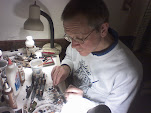Let's start with some particulars: This is a small format book (digest or A5 sized) of about 165 pages. Chapters are included on Resources (5 pp), Basic DIY (8 pp), Making a Table (11 pp), The Playing Surface (9 pp), Figures (20 pp), Terrain (18 pp), Man-Made Features (32 pp), Ships and Planes (11 pp), Storage and Transportation (11 pp), and The Game (37 pp). The book is available in the US for 30 dollars and in the UK for 15 pounds.
Mr. Dickie's sense of humor is very apparent in the book. Interspersed with practical suggestions (e.g. collect twigs or hedge clippings for various purposes) are samples such as this (on the subject of proper precautions to be taken when going outside): "Before you do this I want to offer some much-needed safety advice. Gardens are dangerous places and as soon as the Health and Safety Executive catches on they will be closed down, I'm sure. There are plants that will sting you or stab you; insects that will bite, poison or sting you too; slimy things that will make you slip up and birds that crap on you. You should wear stout industrial boots, water and poo-proof clothes, gloves, and protection for your head. Full NBC kit should do quite nicely." This should give you an idea of what you will be in for as a reader; personally, I find that a very little of this goes a long way, and I found it irritating for page after page.
The chapters on DIY, tables, and storage in particular, and portions of the material on man-made scenery are heavy on woodworking instructions. This appears to be thorough, although it would benefit from a few more diagrams. However, I don't have easy access to table saws and other power tools that would be necessary for what amounts to large scale furniture construction, so I can only make limited use of it.
The sections on scenery are also thorough. There wasn't much in the terrain features that I wasn't already considering, or which isn't already covered by other books in my collection, such as the Games Workshop scenery books, but there was an interesting section on the rationale behind ancient and medieval farm, village and town planning and evolution that isn't intuitive to a North American reader such as myself, living in an area where a building over 50 years old is practically ancient. I can see some of that being incorporated into work to be done on the medieval skirmish project in the next few months.
The chapter on games had some discussion of maximizing the utility of your figures by careful choice of projects so that things can be made to do double duty (e.g., unshieded men in tunics armed with javelins can serve in numerous ancient armies), and some basic thoughts on games that can be played with limited numbers of figures (gladiators, raids and skirmishes, etc.) This last is the only thing in the books that seems to justify the subtitle about gaming in small spaces.
On my second read, then, my impression is that there isn't much in this book that is new or innovative. What there is is generally going to be of more use to someone fairly new to the hobby, who won't have run across all these ideas before. It's not a bad book, even if the humor grates on me, but, for me, it was expensive for what I got out of it, which is not a high recommendation for a book on making the most of a limited budget.


I had a flick through a copy - I fear you may be right Rob.
ReplyDelete